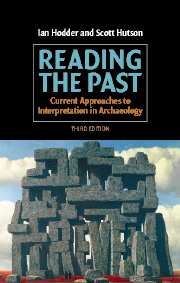Book contents
- Frontmatter
- Contents
- Preface to the first edition
- Preface to the second edition
- Preface to the third edition
- 1 The problem
- 2 Processual and systems approaches
- 3 Structuralist, post-structuralist and semiotic archaeologies
- 4 Marxism and ideology
- 5 Agency and practice
- 6 Embodied archaeology
- 7 Archaeology and history
- 8 Contextual archaeology
- 9 Post-processual archaeology
- 10 Conclusion : archaeology as archaeology
- Bibliography
- Index
3 - Structuralist, post-structuralist and semiotic archaeologies
Published online by Cambridge University Press: 05 June 2012
- Frontmatter
- Contents
- Preface to the first edition
- Preface to the second edition
- Preface to the third edition
- 1 The problem
- 2 Processual and systems approaches
- 3 Structuralist, post-structuralist and semiotic archaeologies
- 4 Marxism and ideology
- 5 Agency and practice
- 6 Embodied archaeology
- 7 Archaeology and history
- 8 Contextual archaeology
- 9 Post-processual archaeology
- 10 Conclusion : archaeology as archaeology
- Bibliography
- Index
Summary
When Edmund Leach (1973) suggested that archaeology would soon turn from functionalism to structuralism, following the path of social anthropology, he was clearly unaware that structuralist archaeology already existed. In particular the work of Leroi-Gourhan (1965), similar in some respects to that of Levi-Strauss, had been widely debated. Certainly structuralism has never dominated the discipline, but its wide-spread attraction cannot be denied (Anati 1994; Bekaert 1998; Bintliff 1984; Campbell 1998; Collet 1993; Deetz 1983; Helskog 1995; Hill 1995; Hingley 1990, 1997; Huffman 1981, 1984; Kent 1984; Lenssen-Erz 1994; Leone 1978; Miller 1982a; Muller 1971; Parker Pearson 1996, 1999; Richard and Thomas 1984; Schnapp 1984; Small 1987; S⊘rensen 1987; Schmidt 1997; Tilley 1991; Van de Velde 1980; Wright 1995; Yates 1989; Yentsch 1991). These various articles, in addition to those to be discussed in this chapter, suggest that one can now talk of a structuralist archaeology.
Yet why has the analysis of ‘structured sets of differences’ been so slow to arrive and so slight in impact? Why has structuralism never formed a major coherent alternative in archaeology? The first answer to these questions is that structuralism is not a coherent approach itself, since it covers a great variety of work, from the structural linguistics of Saussure, and the generative grammar of Chomsky, to the developmental psychology of Piaget and the analysis of ‘deep’ meanings by Levi-Strauss.
- Type
- Chapter
- Information
- Reading the PastCurrent Approaches to Interpretation in Archaeology, pp. 45 - 74Publisher: Cambridge University PressPrint publication year: 2003
- 1
- Cited by

